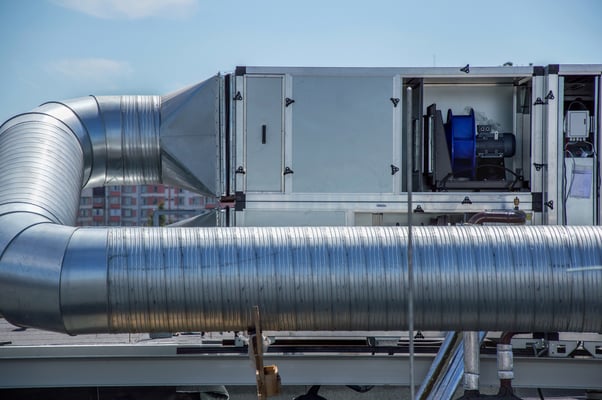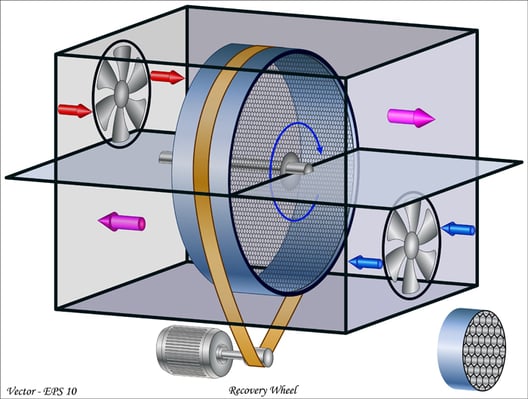Efficient Outdoor Air Ventilation: ERVs and Airside Economizers

ASHRAE recommends increasing the outdoor airflow as much as possible to help prevent COVID-19 in buildings. This comes with a significant energy cost since more outdoor air must be conditioned. However, an energy recovery ventilator (ERV) or an airside economizer can help offset the additional cost.
Before installing an ERV system or an airside economizer, building owners should get an assessment by a professional HVAC engineering firm. The effectiveness of these technologies varies depending on several conditions, including the local climate. Two identical airside economizers can have varying results when used in different locations, and the same applies to energy recovery ventilators.
Improve your ventilation system and indoor air quality, and reduce the risk of COVID-19 transmission.
Coronavirus prevention has priority over energy efficiency until the outbreak is contained. However, there are still opportunities to save energy without compromising the health of building occupants. For example, demand-controlled ventilation (DCV) systems reduce outdoor airflow in response to occupancy, and ASHRAE recommends disabling them to allow more outdoor air. However, an airside economizer does not interfere with outdoor air ventilation, and the system may even allow higher ventilation under some weather conditions.
How an Airside Economizer Can Increase Outdoor Air Ventilation

A building needs space heating or air conditioning depending on the time of the year. Some applications require permanent heating or permanent cooling, depending on the time of the year. For example, a large data center may need cooling 24/7/365 to manage all the heat released by IT equipment.
Under some weather conditions, the outdoor air may have adequate temperature and humidity to be used instead of air conditioning. An airside economizer can detect this, and the outdoor air supply is increased. Since the outdoor air is providing free cooling, air conditioning systems can reduce their output, saving energy. Under the most favorable conditions, the airside economizer may assume the full cooling load of air conditioning systems.
During the coronavirus emergency, an airside economizer has a dual benefit. It contributes to the increased outdoor airflow recommended by ASHRAE while saving on air conditioning. The energy savings and outdoor ventilation from an airside economizer can be increased further by setting the thermostat higher during summer. For unoccupied buildings, ASHRAE recommends a cooling setpoint of 80°F and a maximum relative humidity of 60%.
Using Energy Recovery Ventilation With Increased Outdoor Airflow

There are two types of ERV systems: a heat recovery ventilator (HRV) exchanges only heat between both airstreams, while an enthalpy recovery ventilator (ERV) exchanges both heat and humidity. These systems can save plenty of energy, especially when the outdoor airflow is increased. However, if mixing is not controlled between the two airstreams, ERV can have a negative effect on indoor air quality.
The AHRI Standard 1060 used a metric called the Exhaust Air Transfer Ratio (EATR) to describe air mixing in ERV systems. The EATR should ideally be kept below 5%, but well-designed systems can go as low as 1-3%. Air mixing in an ERV can be minimized by keeping a higher pressure on the air supply side.
Eliminating air mixing is not possible, but ERV can allow a higher outdoor air supply with less recirculation. The air quality impact of mixing in an ERV system is small compared with the negative effect of recirculating indoor air. An ERV system also improves humidity control, and the building can stay within the recommended 40-60% RH range more easily. This humidity range minimizes biological hazards like viruses, bacteria, and fungal growth.
Conclusion
When buildings increase their outdoor airflow, as recommended by ASHRAE to prevent COVID-19, airside economizers, and energy recovery ventilators can help conserve energy. Using an airside economizer is straightforward, as long as the local climate is suitable. However, an ERV should only be deployed if air mixing can be minimized.
Regardless of how a ventilation system is configured, ASHRAE recommends high-efficiency air filters combined with UVGI (Ultraviolet Germicidal Irradiation). There are many air purification methods, but ASHRAE prefers the combination of increased outdoor air, MERV 13 or better filters, and UV disinfection.

Anuj Srivastava
Anuj Srivastava is a principal partner at NY Engineers. He is known for his MEP franchise market knowledge. Anuj is currently leading a team of 100+ MEP/FP engineers and has successfully led over 1500 franchise projects in the US.
Join 15,000+ Fellow Architects and Contractors
Get expert engineering tips straight to your inbox. Subscribe to the NY Engineers Blog below.

